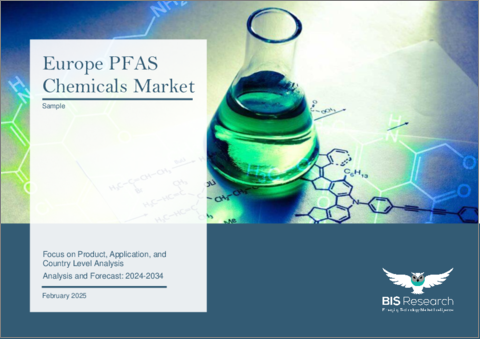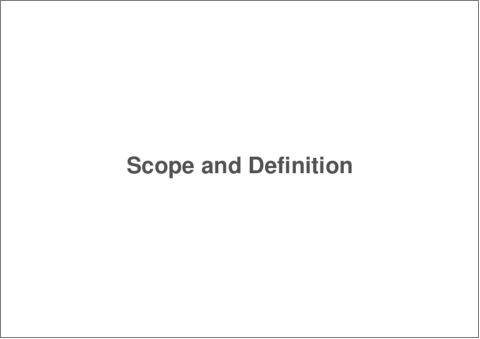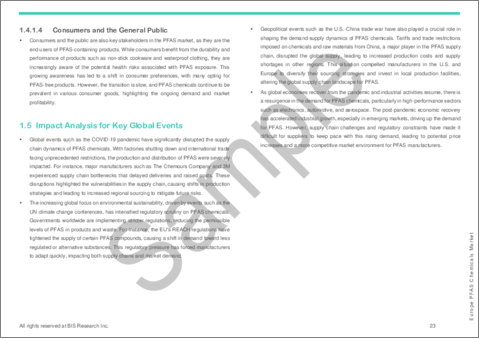|
|
市場調査レポート
商品コード
1668775
欧州のPFAS化学品市場:製品・用途・国別の分析・予測 (2024-2034年)Europe PFAS Chemicals Market: Focus on Product, Application, and Country Level Analysis - Analysis and Forecast, 2024-2034 |
||||||
カスタマイズ可能
|
|||||||
| 欧州のPFAS化学品市場:製品・用途・国別の分析・予測 (2024-2034年) |
|
出版日: 2025年03月05日
発行: BIS Research
ページ情報: 英文 77 Pages
納期: 1~5営業日
|
全表示
- 概要
- 図表
- 目次
欧州のPFAS化学品の市場規模は、2024年の73億1,000万米ドルから、予測期間中は5.47%のCAGRで推移し、2034年には124億6,000万米ドルに達すると予測されています。
欧州のPFAS化学品の市場は、法規制の強化や環境の持続可能性の重視により、大幅な成長が見込まれています。より安全な代替品へのニーズは、PFAS暴露に伴う健康被害に対する社会的認識によって高まっています。安全性と技術革新に焦点を当てた検出および浄化技術の進歩は、よりクリーンな産業慣行とより厳格な規制遵守を促進しながら、PFASの管理に革命をもたらしています。
| 主要市場統計 | |
|---|---|
| 予測期間 | 2024-2034年 |
| 2024年評価 | 73億1,000万米ドル |
| 2034年予測 | 124億6,000万米ドル |
| CAGR | 5.47% |
欧州におけるPFAS化学品の市場は、規制当局の監視の強化や環境持続性への取り組みの高まりにより、大幅な成長が見込まれています。永遠の化学品として知られるパーフルオロアルキル物質とポリフルオロアルキル物質(PFAS) は、その環境残留性と健康への悪影響の可能性に関心が寄せられています。これらの化学品への暴露の危険性に対する認識が高まる中で、官民ともに、汚染問題に対処し、PFASへの依存を減らすための積極的な行動が取られています。
さまざまな業界の企業が、より安全で環境に優しい代替物質を見つけるための研究開発や、より優れた検出技術の開発に資金を費やしており、こうした代替物質への需要の高まりに応えています。禁止や制限を含む厳しい規制が技術革新を促し、PFASフリー製品や高度な浄化・ろ過システムの新技術開発を後押ししています。
市場セグメンテーション
セグメンテーション1:用途別
- 建築・建設
- エレクトロニクス
- 化学 (石油化学を含む)
- 金属製造
- 塗料・コーティング
- 発泡剤、冷媒・冷却剤、難燃剤
- プラスチック・ゴム製造
- その他
セグメンテーション2:製品タイプ別
- フルオロテトラマー系物質
- パーフルオロアルカンスルホニル系物質
- パーフルオロアルキルカルボニル系物質
- パーフルオロ (ポリ) エーテル系物質
- フルオロポリマー
- その他
セグメンテーション3:国別
- ドイツ
- 英国
- フランス
- イタリア
- スペイン
- その他
当レポートでは、欧州のPFAS化学品の市場を調査し、主要動向、市場影響因子の分析、法規制環境、技術開発・特許の動向、ケーススタディ、市場規模の推移・予測、各種区分・主要国別の詳細分析、競合情勢、主要企業のプロファイルなどをまとめています。
目次
エグゼクティブサマリー
範囲と定義
第1章 市場
- 動向:現在および将来の影響評価
- PFASの浄化と環境浄化技術への注目
- さまざまな産業におけるフッ素ポリマーの幅広い用途
- サプライチェーンの概要
- バリューチェーン分析
- 価格予測
- 研究開発レビュー
- 特許出願動向 (国・企業別)
- 規制状況
- PFASの潜在市場規模
- ステークホルダー分析
- 使用事例
- 主要な世界的イベントの影響分析
- 市場力学の概要
- 市場促進要因
- 市場抑制要因
- 市場機会
第2章 地域
- 地域別概要
- 推進要因・抑制要因
- 欧州 (国別)
第3章 市場:企業プロファイル
- 次なるフロンティア
- 地理的評価
- Archroma
- Arkema
- BASF
- Bayer AG
- Merck KGaA
- Solvay
第4章 調査手法
List of Figures
- Figure 1: Europe PFAS Chemicals Market (by Scenario), $Million, 2023, 2027, and 2034
- Figure 2: PFAS Chemicals Market (by Region), $Million, 2023, 2027, and 2034
- Figure 3: Europe PFAS Chemicals Market (by Application), $Million, 2023, 2027, and 2034
- Figure 4: Europe PFAS Chemicals Market (by Product Type), $Million, 2023, 2027, and 2034
- Figure 5: Key Events
- Figure 6: Supply Chain Analysis for PFAS Chemicals Market
- Figure 7: Patent Filed (by Country), January 2021-July 2024
- Figure 8: Patent Filed (by Company), January 2021-July 2024
- Figure 9: Impact Analysis of PFAS Chemicals Market Navigating Factors, 2023-2034
- Figure 10: Total Volume of Sales (in Tonnes) per Year (2010-2022) in France
- Figure 11: Capital Expenditure in Global Semiconductor Industry, $Billion, 2018-2022
- Figure 12: Germany PFAS Chemicals Market, $Million, 2023-2034
- Figure 13: Italy PFAS Chemicals Market, $Million, 2023-2034
- Figure 14: U.K. PFAS Chemicals Market, $Million, 2023-2034
- Figure 15: France PFAS Chemicals Market, $Million, 2023-2034
- Figure 16: Spain PFAS Chemicals Market, $Million, 2023-2034
- Figure 17: Rest-of-Europe PFAS Chemicals Market, $Million, 2023-2034
- Figure 18: Strategic Initiatives, January 2021-July 2024
- Figure 19: Share of Strategic Initiatives, January 2021-July 2024
- Figure 20: Data Triangulation
- Figure 21: Top-Down and Bottom-Up Approach
- Figure 22: Assumptions and Limitations
List of Tables
- Table 1: Market Snapshot
- Table 2: Opportunities Across Region
- Table 3: Competitive Landscape Snapshot
- Table 4: Trends Overview
- Table 5: Regulatory-Related Actions from the Environmental Protection Agency's (EPA) PFAS Action Plan That Are Ongoing
- Table 6: Major Applications and Uses of Fluoropolymers
- Table 7: Average Sales Pricing Forecast of Europe PFAS Class Chemicals and Polytetrafluoroethylene (PTFE), $Thousand/Metric Ton, 2023-2034
- Table 8: EU PFAS Chemicals Existing Regulatory Framework
- Table 9: EU PFAS Chemicals Emerging Regulatory Framework
- Table 10: PFAS Chemicals Market (by Region), $Million, 2023-2034
- Table 11: Germany PFAS Chemicals Market (by Application), $Million, 2023-2034
- Table 12: Germany PFAS Chemicals Market (by Product Type), $Million, 2023-2034
- Table 13: Italy PFAS Chemicals Market (by Application), $Million, 2023-2034
- Table 14: Italy PFAS Chemicals Market (by Product Type), $Million, 2023-2034
- Table 15: U.K. PFAS Chemicals Market (by Application), $Million, 2023-2034
- Table 16: U.K. PFAS Chemicals Market (by Product Type), $Million, 2023-2034
- Table 17: France PFAS Chemicals Market (by Application), $Million, 2023-2034
- Table 18: France PFAS Chemicals Market (by Product Type), $Million, 2023-2034
- Table 19: Spain PFAS Chemicals Market (by Application), $Million, 2023-2034
- Table 20: Spain PFAS Chemicals Market (by Product Type), $Million, 2023-2034
- Table 21: Rest-of-Europe PFAS Chemicals Market (by Application), $Million, 2023-2034
- Table 22: Rest-of-Europe PFAS Chemicals Market (by Product Type), $Million, 2023-2034
- Table 23: Market Share, 2023
Introduction to Europe PFAS Chemicals Market
The Europe PFAS chemicals market is projected to reach $12.46 billion by 2034 from $7.31 billion in 2024, growing at a CAGR of 5.47% during the forecast period 2024-2034. Europe's market for PFAS chemicals is expected to grow significantly due to tighter laws and a greater emphasis on environmental sustainability. The need for safer substitutes is being driven by public awareness of the health hazards associated with PFAS exposure. With a focus on safety and innovation, advances in detection and remediation technologies are revolutionizing the management of PFAS by promoting cleaner industrial practices and more stringent regulatory compliance.
Market Introduction
| KEY MARKET STATISTICS | |
|---|---|
| Forecast Period | 2024 - 2034 |
| 2024 Evaluation | $7.31 Billion |
| 2034 Forecast | $12.46 Billion |
| CAGR | 5.47% |
The market for PFAS chemicals in Europe is expected to grow significantly as a result of heightened regulatory scrutiny and growing environmental sustainability commitment. Known as ""forever chemicals,"" per- and polyfluoroalkyl substances (PFAS) are drawing more attention because of their environmental persistence and possible negative health effects. Both the public and private sectors are acting proactively to address contamination issues and lessen dependency on PFAS as awareness of the dangers of exposure to these chemicals increases.
Businesses from a variety of industries are spending money on research and development to find safer, more eco-friendly alternatives as well as better detection techniques in response to the growing demand for these alternatives. Stringent regulations, including bans and restrictions, are driving innovation and encouraging the development of new technologies for PFAS-free products, as well as advanced remediation and filtration systems.
Furthermore, the shift towards greener industrial processes, combined with increased public concern about PFAS pollution, is reshaping how industries approach production and waste management. Additionally, market participants are concentrating on enhancing detection methods, cleaning up the environment, and complying with stricter laws. These factors will influence the PFAS chemicals market in Europe, where innovation, safety, and environmental responsibility are essential to its future expansion.
Market Segmentation
Segmentation 1: by Application
- Building and Construction
- Electronics Industry
- Chemical Industry (including Petrochemicals)
- Metal Manufacturing
- Paints and Coatings
- Blowing Agents, Refrigerants and Coolants, and Flame Retardants
- Production of Plastics and Rubber
- Others
Segmentation 2: by Product Type
- Fluorotelomer-Based Substances
- Perfluoroalkane Sulfonyl-Based Substances
- Perfluoroalkyl Carbonyl-Based Substances
- Perfluoro(poly)ether-Based Substances
- Fluoropolymers
- Others
Segmentation 3: by Country
- Germany
- U.K.
- France
- Italy
- Spain
- Rest-of-Europe
How can this report add value to an organization?
Product/Innovation Strategy: This report provides a comprehensive product/innovation strategy for the Europe PFAS chemicals market, identifying opportunities for market entry, technology adoption, and sustainable growth. It offers actionable insights, helping organizations to meet environmental standards, gain a competitive edge, and capitalize on the increasing demand for eco-friendly solutions in various industries.
Growth/Marketing Strategy: This report offers a comprehensive growth and marketing strategy designed specifically for the Europe PFAS chemicals market. It presents a targeted approach to identifying specialized market segments, establishing a competitive advantage, and implementing creative marketing initiatives to optimize market share and financial performance. By harnessing these strategic recommendations, organizations can elevate their market presence, seize emerging prospects, and efficiently propel revenue expansion.
Competitive Strategy: This report crafts a strong competitive strategy tailored to the Europe PFAS chemicals market. It evaluates market rivals, suggests stand-out methods, and offers guidance for maintaining a competitive edge. By adhering to these strategic directives, companies can position themselves effectively in the face of market competition, ensuring sustained prosperity and profitability.
Key Market Players and Competition Synopsis
The companies profiled in the report have been selected based on input gathered from primary experts and analyzing company coverage, product portfolio, and market penetration.
Some of the prominent names in this market are:
- Archroma
- Arkema
- BASF
- Bayer AG
- Merck KGaA
- Solvay
Table of Contents
Executive Summary
Scope and Definition
1 Markets
- 1.1 Trends: Current and Future Impact Assessment
- 1.1.1 Increasing Focus on PFAS Remediation and Environmental Cleanup Technologies
- 1.1.2 Extensive Applications of Fluoropolymers across Various Industries
- 1.2 Supply Chain Overview
- 1.2.1 Value Chain Analysis
- 1.2.2 Pricing Forecast
- 1.3 Research and Development Review
- 1.3.1 Patent Filing Trend (by Country and Company)
- 1.4 Regulatory Landscape
- 1.5 Total Addressable Market for PFAS
- 1.6 Stakeholder Analysis
- 1.6.1 Use Case
- 1.6.1.1 Government and Regulatory Bodies
- 1.6.1.2 Manufacturers and Industrial Users
- 1.6.1.3 Environmental and Public Health Advocates
- 1.6.1.4 Consumers and the General Public
- 1.6.1 Use Case
- 1.7 Impact Analysis for Key Global Events
- 1.8 Market Dynamics Overview
- 1.8.1 Market Drivers
- 1.8.1.1 Critical Role of PFAS in High-Performance Industries
- 1.8.1.2 Rising Demand for PFAS in Consumer Goods Driven by Performance Benefits
- 1.8.2 Market Restraints
- 1.8.2.1 Financial and Legal Liabilities Hindering PFAS Market Expansion
- 1.8.2.2 Detrimental Impact on Human Health Impeding Market Growth
- 1.8.3 Market Opportunities
- 1.8.3.1 Growing Demand in Electronics and Aerospace
- 1.8.3.2 Sustained Use in Consumer Goods Despite Regulatory Pressure
- 1.8.1 Market Drivers
2 Regions
- 2.1 Regional Summary
- 2.2 Drivers and Restraints
- 2.2.1 Europe (by Country)
- 2.2.1.1 Germany
- 2.2.1.1.1 Application
- 2.2.1.1.2 Product
- 2.2.1.2 Italy
- 2.2.1.2.1 Application
- 2.2.1.2.2 Product
- 2.2.1.3 U.K.
- 2.2.1.3.1 Application
- 2.2.1.3.2 Product
- 2.2.1.4 France
- 2.2.1.4.1 Application
- 2.2.1.4.2 Product
- 2.2.1.5 Spain
- 2.2.1.5.1 Application
- 2.2.1.5.2 Product
- 2.2.1.6 Rest-of-Europe
- 2.2.1.6.1 Application
- 2.2.1.6.2 Product
- 2.2.1.1 Germany
- 2.2.1 Europe (by Country)
3 Markets - Company Profiles
- 3.1 Next Frontiers
- 3.2 Geographic Assessment
- 3.2.1 Archroma
- 3.2.1.1 Overview
- 3.2.1.2 Top Products/Product Portfolio
- 3.2.1.3 Top Competitors
- 3.2.1.4 Target End-Use Industries
- 3.2.1.5 Key Personnel
- 3.2.1.6 Analyst View
- 3.2.1.7 Market Share, 2023
- 3.2.2 Arkema
- 3.2.2.1 Overview
- 3.2.2.2 Top Products/Product Portfolio
- 3.2.2.3 Top Competitors
- 3.2.2.4 Target End-User Industries
- 3.2.2.5 Key Personnel
- 3.2.2.6 Analyst View
- 3.2.2.7 Market Share, 2023
- 3.2.3 BASF
- 3.2.3.1 Overview
- 3.2.3.2 Top Products/Product Portfolio
- 3.2.3.3 Top Competitors
- 3.2.3.4 Target End-User Industries
- 3.2.3.5 Key Personnel
- 3.2.3.6 Analyst View
- 3.2.3.7 Market Share, 2023
- 3.2.4 Bayer AG
- 3.2.4.1 Overview
- 3.2.4.2 Top Products/Product Portfolio
- 3.2.4.3 Top Competitors
- 3.2.4.4 Target End-Use Industries
- 3.2.4.5 Key Personnel
- 3.2.4.6 Analyst View
- 3.2.4.7 Market Share, 2023
- 3.2.5 Merck KGaA
- 3.2.5.1 Overview
- 3.2.5.2 Top Products/Product Portfolio
- 3.2.5.3 Top Competitors
- 3.2.5.4 Target End-User Industries
- 3.2.5.5 Key Personnel
- 3.2.5.6 Analyst View
- 3.2.5.7 Market Share, 2023
- 3.2.6 Solvay
- 3.2.6.1 Overview
- 3.2.6.2 Top Products/Product Portfolio
- 3.2.6.3 Top Competitors
- 3.2.6.4 Target End-User Industries
- 3.2.6.5 Key Personnel
- 3.2.6.6 Analyst View
- 3.2.6.7 Market Share, 2023
- 3.2.1 Archroma
4 Research Methodology
- 4.1 Data Sources
- 4.1.1 Primary Data Sources
- 4.1.2 Secondary Data Sources
- 4.1.3 Data Triangulation
- 4.2 Market Estimation and Forecast





